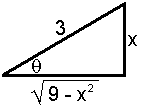Trigonometric Substitutions
Consider the integral
At first glance, we might try the substitution u = 9-x2, but this
will actually make the integral even more complicated!
Let's try a different approach:
The radical
represents the length of the base of a right triangle with
height x and hypotenuse of length 3:
 For this triangle, sinθ =
x/3, suggesting the substitution x =
3sinθ. Then θ =
arcsin(x/3), where we specify
-π/2 ≤
θ ≤
π/2. Note that dx =
3cosθ dθ and that
For this triangle, sinθ =
x/3, suggesting the substitution x =
3sinθ. Then θ =
arcsin(x/3), where we specify
-π/2 ≤
θ ≤
π/2. Note that dx =
3cosθ dθ and that
With this change of variables,
∫ |
dx
|
= |
∫ |
3cosθ dθ
3cosθ |
= |
∫ |
dθ = θ+C = arcsin |




 |
x
3
|




 |
+C. |
Caution!
-
The sketch of the triangle is very useful for determining what
substitution should be made. Note, though, that the sketch only has
meaning for x > 0 and
θ > 0.
-
It is important to be careful about how the angle
θ is defined. With the restrictions on
θ mentioned in the examples here, we avoid
sign difficulties even when x < 0.
There are two other trigonometric substitutions useful in integrals
with different forms:
Example
Let's evaluate
The radical
suggests a triangle with hypotenuse of length
x and base of length 2:
 For this triangle, secθ =
x/2, we we will try the substitution x =
2secθ. Then θ =
sec-1 (x/2), where we specify 0
≤ θ
< π/2 or π
≤ θ
< 3π/2. Note that dx =
2secθtanθ dθ and that
For this triangle, secθ =
x/2, we we will try the substitution x =
2secθ. Then θ =
sec-1 (x/2), where we specify 0
≤ θ
< π/2 or π
≤ θ
< 3π/2. Note that dx =
2secθtanθ dθ and that
Then
⌠
⌡
|
dx
|
= |
⌠
⌡
|
2secθtanθ
(2secθ)2(2tanθ)
|
dθ = |
⌠
⌡
|
1
4
|
cosθ dθ = |
1
4
|
sinθ+C. |
But we see from the sketch that
so
|
|
⌠
⌡
|
|
dx
|
= |
_____
√ x2-4
4x
|
+ C. |
We may also use a trigonometric substitution to evaluate a
definite integral, as long as care is taken in working with
the limits of integration:
Example
We will evaluate
The factor (1+x2) suggests a triangle with base of length 1 and height x:
 For this triangle, tanθ = x, so we will try
the substitution x = tanθ. Then
θ = tan-1(x), where we specify
-π/2 < θ < π/2. Here, dx = sec2θ dθ. Also,
For this triangle, tanθ = x, so we will try
the substitution x = tanθ. Then
θ = tan-1(x), where we specify
-π/2 < θ < π/2. Here, dx = sec2θ dθ. Also,
so
(1+x2)2 = sec4θ.
Then
|
|
= |
⌠
⌡
|
π/4
-π/4
|
sec2θ
sec4θ
|
dθ |
The new limits of
integration follow from:
π/4 = arctan(1)
-π/4 =
arctan(-1) |
|
|
|
= |
|
|
= |
⌠
⌡
|
π/4
-π/4
|
1
2
|
(1+cos2θ) dθ |
|
|
= |
1
2
|
(θ+[1/ 2]sin2θ) |
|
|
| |
π/4
-π/4
|
|
|
= |
1
2
|





 |
π
4
|
+ |
1
2
|





 |
- |
1
2
|





 |
- |
π
4
|
- |
1
2
|





 |
|
|
= |
π
4
|
+ |
1
2
|
. |
We could also have converted the
indefinite integral result back
to the variable x and evaluated
the result at x = 1 and x = -1. |
|
|
There is often more than one way to solve a particular integral. A
trigonometric substitution will not always be necessary, even when the
types of factors seen above appear. With practice, you will gain
insight into what kind of substitution will work best for a particular
integral.